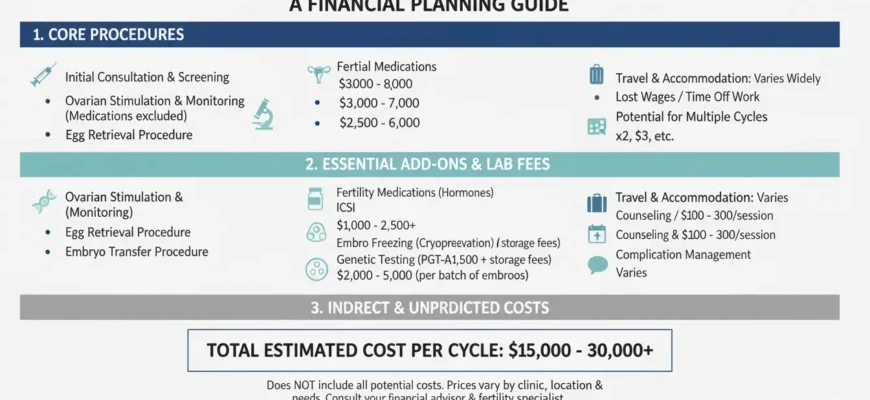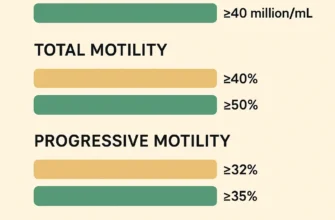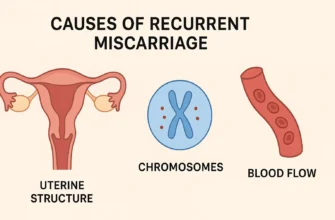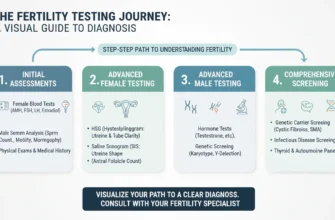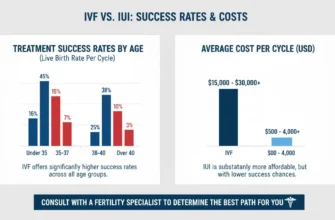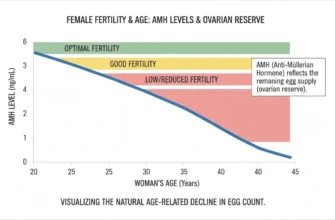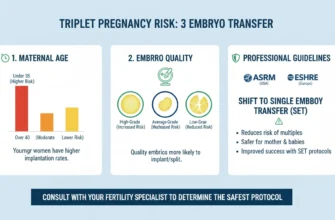Navigating the IVF Journey and Its Financial Realities
The path to parenthood through In Vitro Fertilization (IVF) is a journey of profound hope, resilience, and significant personal investment. For many prospective parents in the United States, however, the initial excitement is quickly tempered by a daunting question: “How much will this cost?” The financial realities of fertility treatment can feel overwhelming, with prices that are often opaque and highly variable. This guide is designed to demystify the true cost of IVF, providing a clear roadmap for affording treatment, whether you have comprehensive insurance or are navigating the process on your own. Understanding the financial landscape is the first step toward taking control of your family-building journey and making informed decisions with confidence.
The history of assisted reproductive technology is both remarkable and encouraging. Louise Brown, born on July 25, 1978, became the first human conceived through In Vitro Fertilization, marking a watershed moment in reproductive medicine. Today, millions of individuals and couples pursue IVF and other assisted reproductive technology options to build their families.
The Emotional and Financial Landscape of Fertility Treatment
Embarking on fertility treatment is an emotionally charged experience, and the financial stress can amplify the pressure. The uncertainty of both the outcome and the final bill creates a unique and challenging environment. Couples and individuals often face difficult decisions, balancing the desire for a child with the practicalities of their budget. Acknowledging this dual challenge—the emotional and the financial—is crucial. By breaking down the costs, exploring funding options, and developing a strategic plan, you can alleviate some of the financial anxiety, allowing you to focus more of your energy on the treatment process itself and your overall well-being.
Research indicates that behavioral health support and mental health counseling significantly improve treatment outcomes and reduce treatment abandonment. Many fertility care providers now recognize that addressing psychological well-being is as important as the medical procedures themselves.
Deconstructing the “True Cost” of an IVF Cycle
The advertised price of an IVF cycle is rarely the final number on your bill. The “true cost” is a composite figure, combining core medical procedures with essential add-ons and a range of indirect expenses. Understanding each component is vital for accurate budgeting and avoiding financial surprises.
Core Medical Procedures: Understanding the Foundational Expenses
The base price for a single cycle of IVF in 2025 ranges from $12,000 to $18,000, though prices vary significantly by clinic and location. This represents an increase from 2020s pricing and typically covers a standard set of procedures. These are the non-negotiable steps of the treatment for most IVF cycles.
Ovarian Stimulation and Monitoring: This includes blood draws and transvaginal ultrasounds to track follicle growth in response to IVF medications. Multiple monitoring appointments track Ultrasound assessment of follicle development and hormone levels, typically requiring 8-12 visits over 10-14 days.
Egg Retrieval Procedure: A minimally invasive surgical procedure performed under sedation to collect mature eggs from the ovaries. This is the egg retrieval cost, which covers the physician, anesthesiologist, facility use, and embryology lab services. The Egg Retrieval Procedure typically yields 8-15 eggs per cycle, though this varies based on age and ovarian reserve.
Fertilization: In the lab, the retrieved eggs are combined with sperm to facilitate fertilization. This can be done via conventional insemination or Intracytoplasmic Sperm Injection (ICSI), where a single sperm is injected directly into an egg, which often carries an additional fee of $1,000-$2,500. Artificial insemination success rates depend heavily on semen profile quality and egg maturity.
Embryo Culture: The resulting embryos are grown in the lab for several days, allowing embryologists to monitor their development and select the healthiest for transfer. This may include Assisted Hatching, an optional procedure that slightly increases implantation rates by approximately 2-3%, costing $200-$500 extra.
Embryo Transfer: A simple procedure where one or more selected embryos are placed into the uterus, with the hope of implantation and pregnancy. The Embryo Transfer procedure itself is non-invasive and typically takes 5-10 minutes, though monitoring and preparation add to the overall timeline.
Essential Add-Ons and Ancillary Services: Optional But Often Necessary
Beyond the core cycle, most patients will incur additional costs for services that enhance the likelihood of success or are necessary for their specific case.
Fertility Medications: Often one of the largest additional expenses, IVF medications for ovarian stimulation drugs can cost between $3,000 and $7,000 per cycle and are rarely included in the clinic’s package price. The cost breakdown of medications depends on individual protocols, with injectable hormones (Gonal-F, Follistim, Menopur) comprising the bulk of expenses. Flexible Financing options through specialty pharmacies can sometimes reduce medication costs by 10-20%.
Preimplantation Genetic Testing (PGT): This involves screening embryos for chromosomal abnormalities (PGT-A) or specific genetic diseases (PGT-M). While optional, it can increase the chance of a successful pregnancy and reduce live birth rates through miscarriage prevention, adding $3,000-$6,000 to the cost. For couples with known genetic risks, Preimplantation genetic testing provides peace of mind and may be medically necessary.
Embryo Cryopreservation and Storage: If you have viable embryos remaining after the fresh transfer, freezing them for future use is common practice. This involves an initial embryo freezing fee ($500-$1,500) plus embryo storage fees ranging from $500 to $1,500 per year. A subsequent Frozen Embryo Transfer (FET) cycle is less expensive than a full IVF cycle ($3,000-$5,000) but still represents a distinct cost. Many clinics now offer Cycle Coordination services to optimize timing of FET procedures.
Egg Freezing for Fertility Preservation: For individuals preserving fertility, the process is similar to the first half of an IVF cycle (ovarian stimulation and egg retrieval), with its own associated costs for the procedure and long-term storage. Egg freezing is increasingly popular among young professionals seeking to delay childbearing, with success rates improving as technology advances.
Mini IVF Alternative: For patients seeking lower costs or those with diminished ovarian reserve, Mini IVF (also called minimal stimulation IVF) is an alternative that averages $5,736-$14,099 nationally, with mini IVF cycles typically producing fewer eggs but with reduced medication costs.
The Unseen and Indirect Costs: Beyond the Clinic Bill
The financial impact of IVF extends beyond medical bills. These indirect costs are often overlooked but can add up significantly.
Diagnostic Procedures: Before a cycle begins, comprehensive Diagnostic Procedures testing for both partners is required, which may or may not be covered by insurance. Male & Female Testing typically costs $1,000-$3,000 and includes hormone panels, semen profile analysis, infectious disease screening, and imaging. A Semen profile analysis alone costs $200-$500 but is essential for determining fertilization method.
Travel and Accommodation: If your chosen fertility clinic is not local, you must budget for flights, hotels, and meals, especially as monitoring appointments become frequent. Patients traveling to destinations known for high success rates (such as clinics affiliated with CCRM Fertility or Pinnacle Fertility locations) should budget an additional $2,000-$10,000 for travel-related expenses.
Time Off Work: IVF requires numerous appointments, often with little notice. This can mean using vacation days, unpaid leave, or experiencing a loss of income. For employed individuals, estimate 5-10 hours per cycle for appointments during the monitoring phase. Federal employees should review Federal Employee Health Benefits Program changes, as coverage has expanded significantly in 2025.
Mental Health and Counseling Support: Many clinics require or recommend psychological evaluation and ongoing counseling. While sometimes covered by insurance, out-of-pocket costs can range from $100-$300 per session. Behavioral health support has been shown to improve treatment success and reduce treatment abandonment.
Navigating IVF with Insurance: Maximizing Your Coverage
For those with health insurance, understanding your benefits is the most critical financial step. Insurance coverage for fertility treatment varies dramatically by state, employer, and individual insurance plans, ranging from comprehensive coverage to none at all.
The Landscape of State-Mandated Coverage
As of 2025, 21 states and the District of Columbia mandate some form of fertility treatment coverage. However, the scope and depth of coverage vary significantly. Only 11 states—Colorado, Connecticut, Delaware, Maryland, Maine, New Hampshire, New Jersey, New York, Rhode Island, Utah, and Washington D.C.—require both IVF and fertility preservation coverage.
Connecticut requires all insurers to cover artificial insemination, IVF, and various other infertility treatments for individuals unable to conceive after one year if under 35 years old, or after six months if over that age.
Colorado mandates all large group health plans (100+ employees) cover up to three completed egg retrievals with unlimited embryo transfers.
New York requires all large group health plans to cover up to three IVF cycles and prescription medications, with added protection against coverage discrimination based on age, sex, sexual orientation, marital status, or gender identity.
Arkansas requires couples to demonstrate a two-year history of unexplained infertility or have a medical condition contributing to infertility. Additionally, the eggs must be fertilized using the sperm of the patient’s spouse.
California and Texas are “mandate-to-offer” states, meaning health insurance plans must have an infertility insurance option but are not required to provide it in any or all plans.
Other states with mandates include Hawaii, Illinois, Louisiana, Massachusetts, Montana, Ohio, Rhode Island, Utah, and West Virginia, though each has specific eligibility requirements and limitations.
Decoding Your Insurance Coverage and Benefits
Start by becoming an expert on your own policy. Call your insurance plans provider and ask pointed questions. Is In Vitro Fertilization a covered benefit? Is there a lifetime maximum dollar amount or a limit on the number of cycles? Does coverage extend to medications, genetic testing, or cryopreservation? Request a written summary of your benefits for your records. Be aware that some insurance plans require you to try less invasive treatments, like artificial insemination (intrauterine insemination or IUI), before approving IVF.
Strategies for Insured Patients
Once you confirm your coverage, strategy is key. Ensure your fertility clinic is in-network with your insurance coverage to avoid higher out-of-pocket costs. Work closely with the clinic’s financial coordinator; they are experts at navigating pre-authorizations and submitting claims. Keep meticulous records of all communication with your insurance company, including dates, times, and the names of representatives you speak with. If a claim is denied, do not hesitate to file an appeal. Persistence can often lead to a reversal.
Federal Employee Benefits: 2025 Expansion
Federal employees and federal retirees have seen significant improvements to fertility coverage in 2025. The Federal Employee Health Benefits Program (FEHBP) now mandates that all plans provide coverage for artificial insemination methods including Intrauterine Insemination (IUI), intracervical insemination (ICI), and intravaginal insemination. Additionally, all plans cover fertility medications for up to three IVF cycles per year.
Most importantly, every state now offers at least two Federal Employee Health Benefits plan options with IVF coverage. BCBS Standard and GEHA High both offer $25,000 annual benefits for IVF procedures, with fertility drug costs separate from that limit. Even with this expansion, out-of-pocket costs for federal employees typically range from $2,000-$8,000 per cycle depending on the plan and coinsurance requirements.
The Office of Personnel Management also coordinates with the Department of Health and Human Services to ensure comprehensive benefit administration.
When Insurance Falls Short: Supplemental Financing
Even with good insurance, you may face significant out-of-pocket expenses due to deductibles, coinsurance, or non-covered services. This is where supplemental financing becomes important. Health Savings Accounts (HSAs) and Flexible Spending Accounts (FSAs) are excellent tools, allowing you to pay for qualified Medical Expenses with pre-tax dollars. Currently, FSAs allow up to $3,200 in annual pre-tax contributions (2024 limit). Many patients also turn to medical loans or low-interest credit cards to bridge the financial gap left by their insurance plans.
Affording IVF Without Insurance: Self-Pay and Creative Solutions
For the many Americans without insurance coverage for IVF, the path to parenthood requires financial creativity and proactive planning. The prospect of paying entirely out-of-pocket is daunting, but numerous resources exist to make treatment more attainable.
Navigating Cash Pay Rates and Clinic Negotiations
When paying out-of-pocket, you have more flexibility to choose providers based on cost. Many fertility clinics offer discounted package rates for self-pay patients that bundle core services. Don’t be afraid to inquire about these packages or even negotiate. Some clinics may offer payment plans that spread the cost over several months. Researching multiple providers is essential, as prices can vary significantly between different clinics and locations. Pinnacle Fertility clinics, for example, offer Pinnacle Patient Pathways programs with structured Waterfall Approval Process frameworks to help optimize care sequences and costs.
Cash pay rates often provide 10-40% discounts compared to insured rates. Understanding the full price increases year-over-year helps with multi-year planning.
Dedicated Fertility Financing and Loan Programs
Several financial institutions specialize in loans specifically for fertility treatment. These lenders are familiar with the unique costs of IVF and often offer competitive rates and terms tailored to the process. CapexMD and LendingClub Patient Solutions are common choices. CapexMD offers loans ranging from $3,000-$50,000 with 6-60 month repayment terms and competitive fixed rates. LendingClub Patient Solutions provides rates starting at 3.99% with terms up to 84 months, allowing patients to finance IVF, medications, genetic testing, egg freezing, or donor services in one comprehensive loan. Both companies perform credit checks and review loan applications within 24 hours. While taking on debt is a serious decision, these specialized loans can provide the necessary upfront capital to begin treatment without delay. Interest rates vary based on creditworthiness, typically ranging from 3.99%-30.99%.
Refund and Shared Risk Programs: A Calculated Investment
Some fertility clinics offer “shared risk” or “refund” programs. In these arrangements, patients pay a higher, flat fee upfront that covers multiple IVF cycles. If a live birth is not achieved after the specified number of attempts, the clinic refunds a significant portion of the fee. These programs provide financial peace of mind against the risk of unsuccessful treatment, but they are typically more expensive than a single pay-as-you-go cycle and have strict medical eligibility criteria. Gaia’s IVF Guarantee Program offers an innovative approach where patients pay a premium upfront, and if they don’t achieve a live birth, Gaia covers treatment costs. If they do achieve a live birth, they repay over 8 years.
Fertility Grants and Scholarships: Non-Repayable Aid
A number of non-profit organizations offer grants to help individuals and couples afford fertility treatment. These grants do not need to be repaid and can significantly reduce the financial burden. Baby Quest Foundation awards grants twice yearly, providing $2,000-$16,000 (combination of money and medications) to eligible applicants. The application process is competitive but includes a $50 Application fee. RESOLVE: The National Infertility Association maintains comprehensive lists of available grants and scholarships. The application processes are often competitive, but for those who are awarded funding, it can be a transformative gift. Organizations like the Tinina Q. Cade Foundation also offer up to $10,000 per family.
Advanced Considerations: Donor Services, Surrogacy, and Legalities
For some, the path to parenthood involves additional services like donor gametes or surrogacy, each adding a significant layer of complexity and cost to the IVF process. Intended Parents considering these options should carefully review legal fees, agency support, and medical costs.
The Added Layer of Donor Gamete Costs
Using donor eggs or sperm is a common and effective treatment option. The cost of donor sperm is relatively modest ($500-$1,500), but Egg Retrieval for donor cycles and donor egg compensation represent substantial expenses.
Donor egg cycles typically cost $25,000-$45,000 total, including the donor’s compensation ($10,000-$15,000), medical screening, the egg retrieval procedure, fertilization, embryo culture, and embryo transfer. Agency Fees for egg donor matching and coordination add another $5,000-$10,000. Working with a fertility clinic that maintains relationships with established egg banks can sometimes reduce costs.
Male & Female Testing requirements for donor applicants add to overall costs but ensure genetic and health screening.
Understanding the Financial Scope of Gestational Surrogacy
Gestational Surrogacy is the most expensive path to parenthood, with total costs often ranging from $120,000 to $180,000 in 2025. This comprehensive cost structure includes:
-
Surrogate Compensation: $45,000-$80,000 base payment
-
Agency Fees: $25,000-$35,000 for matching and case management
-
Legal Fees: $8,000-$15,000 for contract drafting and Pre-birth orders establishing parental rights
-
Medical Screening & IVF: $20,000-$40,000 for cycles, medications, and monitoring
-
Insurance Coverage for Surrogate: $15,000-$30,000 for pregnancy-related healthcare
-
Miscellaneous: $5,000-$10,000 for travel, maternity clothing, and administrative costs
Surrogate Compensation varies by location and experience level. Traditional Surrogacy (where the surrogate is genetically related to the child) is less common and involves additional legal complexity due to Immunological aspects of infertility and parental rights establishment.
For same-sex male couples, Egg Retrieval from a donor and possibly embryo freezing add $20,000-$40,000 to overall costs. Reproductive attorneys specializing in reproductive law and state-specific laws are essential, as Legal Protections vary considerably. California surrogacy arrangements, for instance, tend toward the higher cost range due to strong legal protections and high demand for surrogate mothers.
Insurance coverage for any aspect of gestational surrogacy is exceedingly rare, with most plans explicitly excluding such coverage.
Navigating Provider Selection and Clinic Transparency
When choosing a fertility clinic, especially for complex treatments, transparency is paramount. A reputable provider will offer a clear, itemized cost estimate upfront, detailing what is and isn’t included in their packages. Inquire about their success rates, particularly for cases similar to yours, and ensure you feel comfortable with their communication and financial counseling processes.
CCRM Fertility and Pinnacle Fertility clinics are known for transparent success rate reporting. Genea IVF operates primarily in Australia and Thailand, with limited U.S. availability. Review CDC success rate data and clinic-specific outcomes before selecting a provider. Verify that the clinic participates with your insurance plans if applicable, and confirm Initial Consult fees and whether they’re applied toward treatment costs.
Beyond the Budget: Mental Health and Advocacy in Your IVF Journey
The financial planning for IVF is intensive, but it’s crucial not to lose sight of your emotional well-being. The process is a marathon, not a sprint, and requires mental and emotional fortitude. Behavioral health services should be viewed as an essential part of fertility care, not an optional luxury.
Prioritizing Mental and Emotional Well-being
The stress of IVF treatment can take a toll on individuals and relationships. Many clinics have on-staff counselors or can refer you to therapists specializing in fertility. Support groups, whether online or in-person, provide a valuable community of people who understand your experience. Research indicates that behavioral health interventions reduce treatment abandonment and improve overall psychological well-being. Prioritizing your mental health is not an indulgence; it is an essential part of a successful treatment journey.
Becoming Your Own Financial Advocate
Throughout this process, you must be your most effective advocate. Ask questions relentlessly. Double-check every bill and insurance explanation of benefits. Understand every line item before you pay. Empowering yourself with knowledge is the best way to maintain control over the financial aspects of your treatment. Request Medical Expenses itemization in writing, and understand whether costs are categorized as diagnostic, procedural, or pharmaceutical.
Utilizing Available Resources and Tools
You are not alone. Utilize online cost calculators, grant databases, and patient forums. Organizations like RESOLVE offer a wealth of information and support networks. By leveraging these tools, you can make more informed decisions and feel more connected and empowered.
Conclusion: Taking Control of Your IVF Financial Path
Navigating the cost of In Vitro Fertilization in the USA is a complex but manageable challenge. By deconstructing the true cost, meticulously examining your insurance coverage, and proactively exploring all available financial resources, you can transform an overwhelming obstacle into a structured plan.
Empowering Your Family-Building Journey
The ultimate goal is parenthood, and financial planning is a powerful tool to help you reach it. Whether you are working with insurance, paying out-of-pocket, or pursuing advanced treatments like Gestational Surrogacy, a strategic and informed approach is your greatest asset. Create a budget, ask for help, advocate for yourself, and remember to care for your emotional well-being along the way. By taking these deliberate steps, you can move forward on your path to building a family with clarity, confidence, and financial control.
Quick Reference: 2025 IVF Cost Summary
| Component | Cost Range | Notes |
|---|---|---|
| Base IVF Cycle | $12,000-$18,000 | Varies by clinic and location |
| Medications | $3,000-$7,000 | Major variable cost |
| ICSI | $1,000-$2,500 | If needed for male factor |
| PGT-A/PGT-M | $3,000-$6,000 | Optional genetic testing |
| Assisted Hatching | $200-$500 | Optional add-on |
| Frozen Embryo Transfer | $3,000-$5,000 | Significantly less than fresh cycle |
| Embryo Storage (annual) | $500-$1,500 | Per year ongoing cost |
| Egg Freezing | $8,000-$15,000 | Procedure + first year storage |
| Mini IVF | $5,736-$14,099 | Lower stimulation alternative |
| Donor Eggs (total) | $25,000-$45,000 | Includes all services and compensation |
| Gestational Surrogacy | $120,000-$180,000 | Comprehensive program |
Additional Resources
-
RESOLVE: The National Infertility Association (resolve.org) – Comprehensive patient education, insurance information by state, and grant listings
-
Baby Quest Foundation (babyquestfoundation.org) – Fertility grants available twice yearly
-
CapexMD (capexmd.com) – Specialized fertility financing with 24-hour approval
-
LendingClub Patient Solutions – Fertility treatment loans with rates starting at 3.99%
-
Gaia (gaiafamily.com) – IVF payment plans with guarantee programs
-
CDC Assisted Reproductive Technology Success Rates – Clinic-by-clinic success data
-
ASRM (American Society for Reproductive Medicine) – Clinical guidelines and provider directory
-
Federal Employee Health Benefits Open Season (feds.opm.gov) – Annual enrollment updates for FEHB fertility coverage

